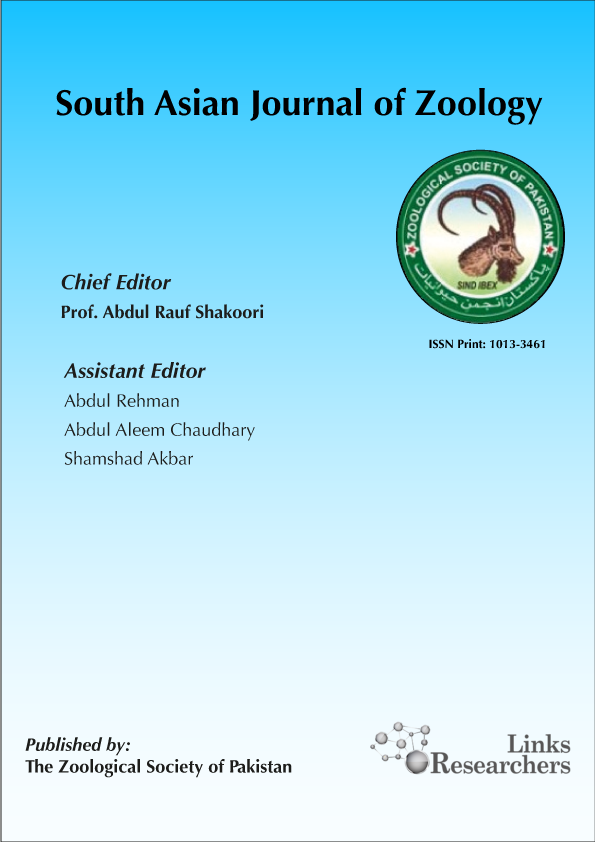Temitope Oluwasegun Cephas Faleye1, Johnson Adekunle Adeniji1, 2 *
Mehwish Kiran*, Muhammad Saleem Jilani*, Kashif Waseem*
and Muhammad Sohail**
Safina Naz1, Muhammad Akbar Anjum1, Saeed Akhtar2, Syed Atif Hasan Naqvi3* and Muhammad Asif Zulfiqar4
Siddra Tayyab Akhtar, Anjum Nasim Sabri
water located in the vicinity of Jinnah hospital Lahore, Pakistan. Six biofilm forming
bacterial strains were selected on the basis of their motility and biofilm forming
ability firstly by growing them on congo red agar medium and then by performing
ring test. By 16S rRNA sequencing, bacterial strains were identified as
Exiguobacterium aurantiacum, Bacillus subtilis, Bacillus megaterium, Bacill...
Daulat Khan1*, Khizar Azam2, Noor Muhammad Khan1, Muhammad Israr1, Naeem Ejaz3
mixing with normal water, into a range that can be used safely for irrigation....
Mumtaz Shah*, Hashim Nisar Hashmi* Naeem Ejaz* Abdul Razzaq Ghumman*
Parakriti Gupta1, Kapil Goyal2 and Mini Pritam Singh3*
Safina Naz1*, Muhammad Akbar Anjum1, Bushra Siddique2, Syed Atif Hasan Naqvi3*, Sajid Ali1, Hassan Sardar1, Sakeena Tul Ain Haider1, Muhammad Asif Zulfiqar4, Hajra Azeem3, Sibghat Ullah5, Shah Pasand6 and Zehri Khan5
Samia Ikram1*, Riaz ur Rehman1, Farwa Batool2 and Atyab Amjad3
Salma Javed, Samreen Khan*, Nasira Kazi and Tabassum Ara Khanum
Mohammad Mahmudi1,2*, Muhammad Musa1,2, Sulastri Arsad1,2, Evellin Dewi Lusiana1,2, Alamanda Bunga1, Nur Azlina Wati1
Sanwal Masood1, Dildar Ahmed2, Silvia Machado1 and Sohaib Aslam1*
Azzami, Mohamed 1.; Hakiml , Aya Salah El-Din; Othman2, Badawi A. and 2 El-Dougoug, Khaled A.
ZOHAIB SAEED1, SHAHID IQBAL*1, UMER YOUNAS1,2, MUHAMMAD PERVAIZ*3, SYED MOHSIN ALI NAQVI3 & RANA RASHAD MAHMOOD KHAN3
ZEESHAN REHMAN1, RANA ABRAR HUSSAIN1, SHAISTA JABEEN2, SAKHAWAT ALI2, ZAHAR NOREEN1 & IRUM MUKHTAR1*
ZAFAR IQBAL KHAN1, KAFEEL AHMAD1, HAREEM SAFDAR1, KINZA WAJID1, HUMAYUN BASHIR1, KHALID NAWAZ2, MAHPARA SHEHZADI3, IJAZ RASOOL NOORKA4, MUDASRA MUNIR1, IFRASALEEM MALIK1, ASMA ASHFAQ1, HIRA MUQADDAS5, HAFSA MEMOONA6, MADIHA SANA6, NAUNAIN MEHMOOD7, SAIF UR REHMAN8 & TASAWAR ABBAS8
Hina Jabeen*, Usman Irshad, Kainat Azhar, Alisha Fatima, Asma Zaheer Abbasi, Tayyaba Sadia and Jaweria Aqeel
Salwa M. Masoud1; Hend A. Refat2; Nada S. Sayed2; Mohamed K. Abd-El Aal2; Ahmed A. Dosocky2; Zeinab S. Mohammed3; Mohamed A. H. Abdel Wahab3; Dina M. Mekawy3; Ali I. Ali4; Basma A. Atya4; Katren T. Welliam4; Rehab M. Abd El-Baky1, 5; Zeinab S. Hashem1*
Mustafa S. Arif1*, Sanaa. A. Mustafa1















